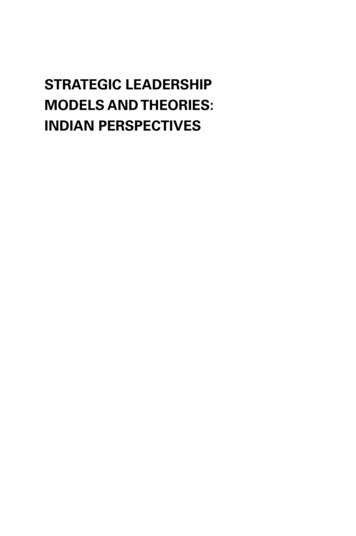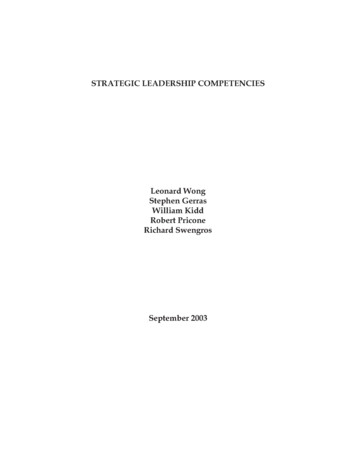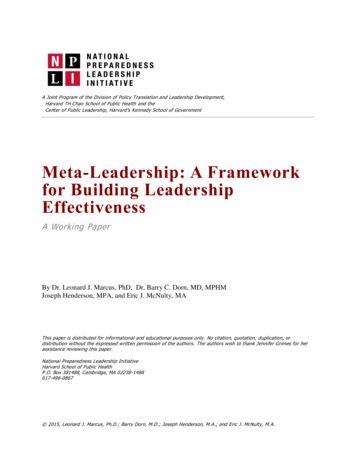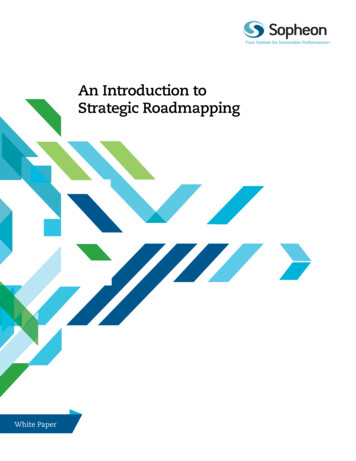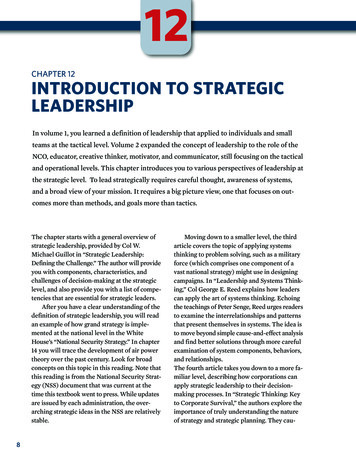
Transcription
12CHAPTER 12INTRODUCTION TO STRATEGICLEADERSHIPIn volume 1, you learned a definition of leadership that applied to individuals and smallteams at the tactical level. Volume 2 expanded the concept of leadership to the role of theNCO, educator, creative thinker, motivator, and communicator, still focusing on the tacticaland operational levels. This chapter introduces you to various perspectives of leadership atthe strategic level. To lead strategically requires careful thought, awareness of systems,and a broad view of your mission. It requires a big picture view, one that focuses on outcomes more than methods, and goals more than tactics.The chapter starts with a general overview ofstrategic leadership, provided by Col W.Michael Guillot in “Strategic Leadership:Defining the Challenge.” The author will provideyou with components, characteristics, andchallenges of decision-making at the strategiclevel, and also provide you with a list of competencies that are essential for strategic leaders.After you have a clear understanding of thedefinition of strategic leadership, you will readan example of how grand strategy is implemented at the national level in the WhiteHouse’s “National Security Strategy.” In chapter14 you will trace the development of air powertheory over the past century. Look for broadconcepts on this topic in this reading. Note thatthis reading is from the National Security Strategy (NSS) document that was current at thetime this textbook went to press. While updatesare issued by each administration, the overarching strategic ideas in the NSS are relativelystable.8Moving down to a smaller level, the thirdarticle covers the topic of applying systemsthinking to problem solving, such as a militaryforce (which comprises one component of avast national strategy) might use in designingcampaigns. In “Leadership and Systems Thinking,” Col George E. Reed explains how leaderscan apply the art of systems thinking. Echoingthe teachings of Peter Senge, Reed urges readersto examine the interrelationships and patternsthat present themselves in systems. The idea isto move beyond simple cause-and-effect analysisand find better solutions through more carefulexamination of system components, behaviors,and relationships.The fourth article takes you down to a more familiar level, describing how corporations canapply strategic leadership to their decisionmaking processes. In “Strategic Thinking: Keyto Corporate Survival,” the authors explore theimportance of truly understanding the natureof strategy and strategic planning. They cau-
VOLUME FOUR STRATEGIC PERSPECTIVESCHAPTER OUTLINEThis chapter’s readings are:Strategic Leadership:Defining the ChallengeCol W. Michael Guillot, “Strategic Leadership:Defining the Challenge,” Air & Space Power Journal(Winter 2003): 67-75.National Security StrategyThe White House, “National Security Strategy,”(May 2010).Leadership and Systems ThinkingCOL George E. Reed, “Leadership and SystemsThinking,” Defense AT&L 35, no. 3 (2006): 10-13.tion that companies that conduct long-rangeplanning incorrectly may actually hinderrather than help their performance.For a specific example of applying innovative concepts with strategic planning, the finalarticle presents the topic of crowdsourcing.This term refers to the relatively new trend ofassigning work to large group of people, whomay be highly-skilled amateurs, rather thanjust a small handful of employees in an organization. The authors of the final article,“Crowdsourcing: What it Means for Innovation,” summarize the current state of thisconcept. As you read the article, you may discover new ways to harness the various talentsof a group of people to meet the needs of yourproject, team, or squadron.Strategic Thinking:Key to Corporate SurvivalBenjamin B. Tregoe and John W. Zimmerman,“Strategic Thinking: Key to Corporate Survival,”Management Review 68, no. 2 (1979): 8-14.Crowdsourcing:What it Means for InnovationAnhai Doan, Raghu Ramarkrishnan, & Alon Y. Halevy,“Crowdsourcing: What it Means for Innovation,”Communications of the ACM 54, no. 4 (2011): 86-96.CHAPTER GOALS1. Comprehend the concept ofstrategic leadership at the nationaland organizational level.2. Summarize the use of systemsthinking for strategic planning.3. Explain how the use of crowdsourcing technologies can helpaccomplish team goals.9
12.1Strategic Leadership: Defining the ChallengeBy Col W. Michael Guillot, USAFOBJECTIVES:1. Define the term “strategic leadership.”2. Identify the four components of the strategic leadership environment, and list factors that belongto each component.3. Describe four characteristics of consequential decisions.4. List and define four challenges of strategic leadership.5. Recall competencies that are essential for leaders who wish to develop strategic leadership skills.The only thing harder than being a strategic leader istrying to define the entire scope of strategic leadership—a broad, difficult concept. We cannot always define it ordescribe it in every detail, but we recognize it in action.This type of leadership involves microscopic perceptionsand macroscopic expectations. Volumes have been writtenon the subject, which may in fact contribute to the difficulty of grasping the concept. One finds confusing andsometimes conflicting information on this blended conceptthat involves the vagaries of strategy and the behavioralart of leadership. Sometimes the methods and modelsused to explain it are more complicated than the conceptand practice of strategic leadership itself. Exercising thiskind of leadership is complicated, but understanding itdoesn’t have to be. Beginning with a definition and characterization of strategic leadership and then exploringcomponents of the strategic environment may provehelpful. Future leaders must also recognize the nature ofthat environment. Finally, they should also have somefamiliarity with ways of developing competencies fordealing with the broad, new challenges that are part ofleading in the strategic environment.WHAT IS STRATEGIC LEADERSHIP?The common usage of the term strategic is related to theconcept of strategy—simply a plan of action for accomplishing a goal. One finds both broad and narrow sensesof the adjective strategic. Narrowly, the term denotesoperating directly against military or industrial installations of an enemy during the conduct of war with the intent of destroying his military potential.1 Today, strategicis used more often in its broader sense (e.g., strategicplanning, decisions, bombing, and even leadership). Thus,we use it to relate something’s primary importance or itsquintessential aspect—for instance, the most advantageous,complex, difficult, or potentially damaging challenge to anation, organization, culture, people, place, or object.When we recognize and use strategic in this broad sense,we append such meanings as the most important long-10range planning, the most complex and profound decisions,and the most advantageous effects from a bombing campaign—as well as leaders with the highest conceptualability to make decisions.As mentioned earlier, strategy is a plan whose aim is tolink ends, ways, and means. The difficult part involves thethinking required to develop the plan based on uncertain,ambiguous, complex, or volatile knowledge, information,and data. Strategic leadership entails making decisionsacross different cultures, agencies, agendas, personalities,and desires. It requires the devising of plans that are feasible, desirable, and acceptable to one’s organization andpartners—whether joint, interagency, or multinational.Strategic leadership demands the ability to make sound,reasoned decisions—specifically, consequential decisionswith grave implications. Since the aim of strategy is tolink ends, ways, and means, the aim of strategic leadership is to determine the ends, choose the best ways, andapply the most effective means. The strategy is the plan;strategic leadership is the thinking and decision makingrequired to develop and effect the plan. Skills for leadingat the strategic level are more complex than those forleading at the tactical and operational levels, with skillsblurring at the seams between those levels. In short, onemay define strategic leadership as the ability of an experienced, senior leader who has the wisdom and vision to createand execute plans and make consequential decisions in thevolatile, uncertain, complex, and ambiguous strategic environment.COMPONENTS OF THE STRATEGICENVIRONMENTWhat is the strategic-leadership environment? One construct includes four distinct, interrelated parts: the national security, domestic, military, and internationalenvironments (fig. 1). Within the strategic environment,strategic leaders must consider many factors and actors.This construct is neither a template nor checklist—nor a
recipe for perfection. The framework recognizes the factthat strategic leaders must conceptualize in both the political and military realms. Additionally, it illustrates howthe strategic environment is interrelated, complementary,and contradictory. Leaders who make strategic decisionscannot separate the components, especially when theyare dealing with the national security environment.Strategic leaders must recognize and understand thecomponents of the national security environment. Theultimate objectives of all US government personnel arethose presented in the national security strategy. Thestrategy and its objectives shape the decision making ofstrategic leaders, who must understand the nationalinstruments of power—political, economic, and military.These instruments provide the means of influence—forexample, political persuasion (diplomacy), economicmuscle (aid or embargo), or military force (actual orthreatened). Within the national security environment,strategic leaders should consider national priorities andopportunities and must know the threats and risks tonational security, as well as any underlying assumptions.Understanding this environment poses a major undertaking for strategic leaders. It is also the foundation forunderstanding the military environment.Personnel who aspire to be strategic leaders, especiallywithin the Department of Defense, must thoroughlyunderstand military strategy. Two reasons come to mind.First, because the military instrument of power has suchgreat potential for permanent change in the strategicenvironment, all strategic leaders must recognize its risksand limitations. Second, because military experienceamong civilian leaders has dwindled over the years andwill continue to do so, strategic leaders have a greaterresponsibility to comprehend policy guidance and clearlyFigure 1understand expected results. Only then can they effectivelyset military objectives and assess the risks of militaryoperations. Such leaders must develop and evaluatestrategic concepts within the military environment andrecognize potential threats. Finally, strategic leaders willhave to balance capabilities (means) against vulnerabilities and, in doing so, remain aware of the domestic coalitionas a major influence.Since the founding of our nation—indeed, even before thesigning of the Constitution—the domestic environmenthas influenced our leaders. Over the last 200 years, littlehas changed in this regard; in fact, most people wouldargue that domestic influence has increased. For instance,strategic leaders today must pay particular attention tothe views, positions, and decisions of Congress, whosepower and influence pervade many areas within thestrategic environment—both foreign and domestic. Congresshas the responsibility to provide resources, and we havethe responsibility to use them prudently and account forthem. This partnership encompasses national and localpolitics, budget battles for scarce dollars, and cost-risktrade-offs. Strategic leaders cannot ignore either thecongressional part of the domestic environment—eventhough the relationship can sometimes prove difficult—orsupport from the population. Such support is extremelyrelevant in democracies and certainly so in the UnitedStates. The problem for the strategic leader lies in accurately measuring public support. Accurate or not, seniorleaders in a democracy ignore public support at theirperil. Actually, because of their power and influence,components of the media make it impossible to ignoredomestic issues. Strategic leaders must know how toengage the media since the latter can help shape thestrategic environment and help build domestic support.Finally, even though the political will may change, environmental activism will continue to affect the decisionsof strategic leaders at every level. Environmentaldegradation remains a concern for strategic leadersin this country, as do problems in the internationalenvironment that call for strategic decisions.When considering the international environment, strategic leaders should first explore thecontext—specifically, the history, culture, religion, geography, politics, and foreign security.Who are our allies? Do we have any alliances inplace, or do we need to build a coalition? Whatresources are involved— physical or monetary? Isdemocracy at stake— creating or defending it?Leaders should also consider threats to the balance of power (BOP) in the environment and theinvolvement of both official and unofficial organizations. The United Nations may already have11
mandates or resolutions that would affect our proposedoperations or interests. Nongovernmental organizationsmay also be willing to help—or perhaps require help.Each of these concerns is legitimate and makes the international environment the most challenging and unfamiliar of them all.This framework for the components of the strategic environment is simple in design yet complicated in practice.Most US government personnel are intimately familiarwith the national security and military environmentssince they are linked (i.e., military strategy follows directlyfrom national security decisions). But strategic leadersmust recognize that the two greatest influences on theirdecisions come from the domestic and international environments. To lead effectively, they should use what ismost familiar and be able to synthesize what influencestheir strategic decisions.The four components of the strategic environment presenta challenge for strategic leaders. The national securityenvironment, with its many taskmasters, will drive bothstrategic decisions and military strategy. Leaders will feelgreat influence from the familiar domestic environmentand must have its support for strategic action. Further,strategic leaders can be surprised and their decisionsthwarted if they fail to understand the international environment sufficiently. Knowing the disparate componentsof the strategic environment is the first step in graspingstrategic leadership. Understanding the nature of thestrategic environment and strategic decisions is thesecond step.NATURE OF THE STRATEGIC ENVIRONMENTThe strategic-leadership environment differs from theclimate at lower levels of leadership. We should view thenature of this environment both broadly—examiningconsequential decisions and changes in performancerequirements—and narrowly.CONSEQUENTIAL DECISIONSBy nature, strategic leadership requires consequentialdecision making. All decisions have consequences, but inthe strategic context, they take on a different character—specifically, they are planned, generally long term, costly,and profound.Consequential decisions occur only at the higher levelswithin organizations. Generally, decision makers in thetop 20 percent of the organization—the people who haveultimate control of resources—plan and execute suchdecisions. They also think out the implications of their12decisions in advance. That is to say, the decision makersanalyze and evaluate the possible, probable, and necessaryramifications of a decision beforehand. Some peopleargue that the sergeant on patrol in Kosovo or the bombercrew over Afghanistan can make strategic decisions in asplit second and thus become strategic decision makers.No doubt, armed forces and government officials do makelethal, destructive, and sometimes regrettable decisions.However, these determinations are considered tacticalopportunities or, worse, operational blunders rather thanplanned, consequential decisions. Planning becomesmore important when one considers the long-term natureof consequential decisions.Such decisions require years to play out. Indeed, in mostcases strategic decision makers may not be around to witness the actual consequences of the decision, making it allthe more essential that they carefully consider all implications before taking action. Clearly, a hasty consequentialdecision can become very costly.One may classify these attendant costs as either immediate or mortgaged. For instance, some consequential decisions—such as declaring war or beginning hostilities—canhave immediate costs or effects. The cost in lives couldbecome very heavy in a matter of days. World economiccosts could mount within weeks while markets collapsewithin hours. Mortgaged costs of consequential decisions,however, refer to lost opportunities and “sunk” costs. Wesee such consequences, for example, when organizationscommit to huge purchases for weapons systems over adecade-long time frame. Of course in the strategic environment, costs are measured not only in dollars but alsoin influence (e.g., the costs of supporting one nation overanother or the costs of not supporting a particular position).Many times, the decision becomes a matter of sunkcosts—gone forever with no chance of recovery. Up to thispoint, we have considered only the negative effects ofcosts on consequential decisions. Suffice it to say thatmany consequential decisions have the aim of decreasing,avoiding, or postponing costs. In fact, some of the leastcostly consequential decisions turn out to be the mostprofound (e.g., expanding free-trade agreements and theNATO alliance, reducing the number of nuclear arms, etc.).Consequential decisions are profound because they havethe potential to create great change, lead trends, alter thecourse of events, make history, and initiate a number ofwide-ranging effects. They can change societies andadvance new disciplines. Most importantly, an entireorganization, a segment of society, a nation, or humanityin general recognizes such decisions as profound.
PERFORMANCE REQUIREMENTSThe stratified systems theory of T. Owen Jacobs andElliott Jaques classifies the performance requirements forleaders in organizations as direct, general, and strategic(in military parlance: tactical, operational, and strategic,respectively).2 Distinct elements define the leadershipenvironment within each level. Unmistakable differencesamong the three levels include complexity, time horizon,and focus.Most people spend their careers leading at the direct ortactical level (squadron or battalion commander, branchchief, or below). In this environment, the leader interactsdirectly with the same people every day by maintaininga direct span of control, all the while executing plans,following policies, and consuming resources with adefined goal in mind. The time horizon is very short—normally less than one year. At the direct level of leadership, communications generally occur within the sameorganization and focus exclusively on the internal audience.Because leaders spend more time at this level than anyother, it becomes familiar and comfortable.Some leaders, however, will mature and move to the generalor operational level, where performance requirementsbegin to change. Direct leadership diminishes as the spanof control shrinks. At this level, leaders develop plans,write some policies, and allocate resources among subordinate organizations. The time horizon also increases—toas much as five years. Operational leaders begin to shiftthe focus of communication and energy outside theorganization, recognizing and questioning how the external environment will affect their organizations. Groupcommanders, brigade commanders, and division chiefsrepresent this general, analytic level of leadership.From the perspective of budding strategic leaders, performance requirements for the strategic level change themost and are the least familiar. The power of influencebecomes more important than the power of the position.Conceptual ability and communications become essential.Both focus not only on how the external environment willaffect the organization, but also—and more importantly—on how the organization can influence that environment.The most challenging of the performance requirements isthe time frame for making decisions, which can extend to20 years and beyond. The leader at this level must think interms of systems and use integrative thinking—the abilityto see linkages and interdependencies within large organizations (or systems) so that decisions in one system willnot adversely affect another system.3 The challenges aregreat, the stakes are high, and the performance requirements are stringent.VOLATILITY, UNCERTAINTY, COMPLEXITY,AND AMBIGUITYFraming the nature of the strategic environment in abroad context helps us understand the magnitude of thechallenge. Strategic leaders operate in an environment thatdemands unique performance requirements for makingconsequential decisions. If we look more closely at thisenvironment, we discover four characteristics that definethe challenge to strategic leadership in a narrow sense:volatility, uncertainty, complexity, and ambiguity.4Now that the world is no longer bipolar, the strategiclandscape has become more volatile. Violence erupts inthe most unlikely places and for seemingly innocuousreasons. The last few years have given us a glimpse of thisvolatility: ethnic cleansing in Bosnia and Kosovo, war andterrorism in the Middle East, and terrorism within theUnited States. The challenge for strategic leaders lies inanticipating volatile scenarios and taking action to avertviolence.In most cases, these leaders will be asked to conduct thisaction in a landscape of uncertainty—the deceptive characteristic of the strategic environment. They face situationsin which the intentions of competitors are not known—perhaps deliberately concealed.5 At other times, they willeven have reservations about the actual meaning of truthful information. Their challenge is to penetrate the fog ofuncertainty that hugs the strategic landscape. Comprehending the nature of the strategic environment constitutes the first step toward solving its complexity.The interdependence of the components in the strategicenvironment produces complexity—its most challengingcharacteristic. Integrative thinking is essential to recognizing and predicting the effects of a decision on this“system of systems.” If leaders are to anticipate the probable, possible, and necessary implications of the decision,they must develop a broad frame of reference or perspective and think conceptually.The ambiguous character of the strategic environmentstems from different points of view, perspectives, andinterpretations of the same event or information. Strategicleaders have to realize that broad perspectives (e.g., usingteam approaches to solve problems and gain consensus)help eliminate ambiguity and lead to effective strategicdecisions.6The nature of the strategic environment is challengingbecause of the consequences of decisions and unique performance requirements. Although faced with an environment characterized by volatility, uncertainty, complexity,13
and ambiguity, aspiring strategic leaders can neverthelesslearn to master it. Indeed, by acquiring certain skills andcompetencies, they can transform this environment intosomething more stable, certain, simple, and clear.DEVELOPING STRATEGIC LEADERSHIPIf becoming a strategist is the “ends,” then leadership isthe “ways,” and development is the “means.” Learning tobecome a strategic leader requires special preparation inseveral areas. First, one must understand how such aleader develops—in essence the anatomy of strategic leadership. Second, one should recognize some of the essentialcompetencies a strategic leader must have. Finally, theprospective leader needs to assess his or her current abilities and commit to a development plan.ANATOMY OF A STRATEGIC LEADERDevelopment of a strategic leader involves a number ofimportant aspects. First, the most important, indeedfoundational, part of this preparation concerns values,ethics, codes, morals, and standards. Second, the path tostrategic leadership resembles the building of a pyramid(fig. 2). Shortcuts do not exist, and one can’t start at thetop—strategic leaders are made, not born. Strategic leadersgradually build wisdom, defined as acquiring experiencesover time.7 One must also remember that certain activitiescan accelerate these experiences and widen perspectives.Leaders should know that even though some individualswith strategic competency may not become strategicdecision makers, they can still influence and contributeto decisions. Additionally, having strategic competencywill allow one to fully understand strategic decisions andperspectives.Figure 2COMPETENCIESIt is difficult to imagine an all-inclusive list of competenciesrequired for strategic leadership. However, some skillsseem essential— vision, for instance, which allows thestrategic leader to focus on the future and, in fact, buildthat future. Vision makes leaders proactive in the strategicenvironment rather than reactive. Furthermore, theyshould become transformational in order to inspire peopletoward common goals and shared values; they mustanticipate change, lead change, and foster a mind-set ofchange; they should critically analyze their own thinkingto make decisions logically; they should foster an attitudeof creativity in their operations and organizations; theymust audaciously seek novel ideas and understand how toframe decisions and organize chaos; and they shouldknow how to build effective teams and gain consensuswithin large organizations. When consensus fails, strategicleaders must negotiate effectively, or they put success atrisk. Many times, this kind of success is directly relatedto the cultural sensitivity and cross-cultural communications ability of the leader. Finally, the strategic leadermust assume the role of both teacher and mentor. As NoelTichy reminds us, great leaders are great teachers. Theyhave a teachable point of view and invest in developingother leaders.8 The competencies mentioned above formthe basis of an education for aspiring strategic leaders.ASSESSMENT AND DEVELOPMENTBecoming a strategic leader is a daunting challenge. Itstarts with taking stock of leadership abilities, conceptualcapacity, and interpersonal skills. A thorough self-assessment will help identify strengths and weaknesses. Suchassessments can examine personality type, leadershipmotivation, originality, innovation, tolerance, teamwork,and conceptual ability. These assessments are like thestarting point on a map, letting prospective leaders knowwhere they are so they can take the best route to theirdestination. Completing a detailed self-assessment is alsothe first step in commitment to the personal and professionaldevelopment process required to become a strategic leader.As a follow-up to the self-assessment, aspiring leadersshould ask themselves a series of questions: What are mystrengths? How can I capitalize on them? Where are myweaknesses? What can I do about them? Where do I wantto be in the future? How can I get there? Do I really wantto commit to development? The last question is the mostdifficult one.9 Those who answer yes are ready to beginthe journey toward becoming strategic leaders.At this point, leader candidates should volunteer for andaccept challenging assignments—especially in areas in14
which they might not have worked before. These couldinclude moving into a different functional area, acceptingjoint assignments, or working in an interagency environment. Such taskings tend to accelerate experience andbroaden perspectives. Furthermore, pursuing a formalcourse of study at senior service colleges and participatingin other education programs would broaden one’s knowledge and conceptual ability. Self-learning is also valuable—especially reading. All strategic leaders are voraciousreaders—and they read outside their normal area ofexpertise, again, to expand their perspective and increasetheir conceptual ability. In fact, many of them are expertsin a number of unrelated fields. Becoming a “dual expert”helps one think in multiple dimensions.NOTES1. Webster’s II New Riverside University Dictionary, 1988 ed., s.v.“strategic.”2. T. Owen Jacobs, Strategic Leadership: The Competitive Edge(Fort Lesley J. McNair, Washington, D.C.: Industrial College of theArmed Forces, 2000), 24.3. US Industrial College of the Armed Forces, chap. 1, “Overview,”Strategic Leadership and Decision Making: Preparing Senior Executives for the 21st Century (Washington, D.C.: National Defense University Press, 1997), on-line, Internet, September 2000, availablefrom eb%2099/cont.html.4. Ibid.After committing to some or all of these developmentactivities, potential leaders should reflect on each activityas a way of mining the total benefit and seeking greatermeaning. They will also benefit from mentoring otherleaders and being mentored themselves. When mentorsshare their experiences, they help others know andunderstand them. As Tichy says, sharing experiences or“telling stories” shapes our own attitude, behavior, andpoint of view.10 We become the story, and the story guidesour lives. Gen Dwight Eisenhower endorsed mentoringwhen he explained that the best way to become a gooddecision maker is to be around others who make decisions.115. Ibid.6. Ibid.7. Jacobs, 46.8. Noel M. Tichy with Eli Cohen, The Leadership Engine: How Winning Companies Build Leaders at Every Level (
12.1 Strategic Leadership: Defining the Challenge By Col W. Michael Guillot, USAF OBJECTIVES: 1. Define the term “strategic leadership.” 2. Identify the four components of the strategic leadership environment, and list factors that belong to each component. 3. Des



